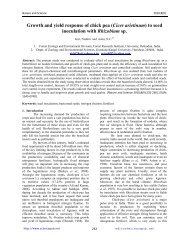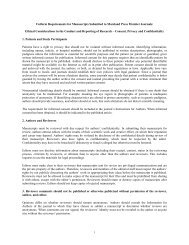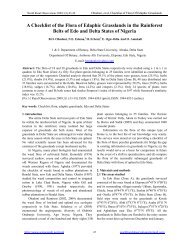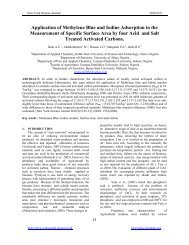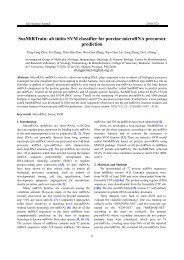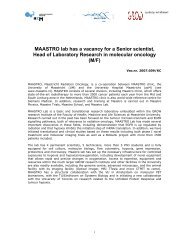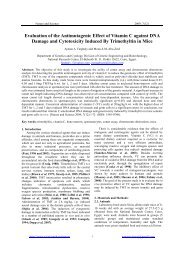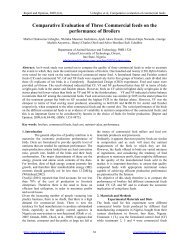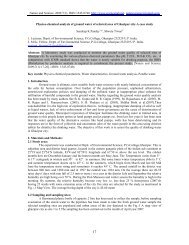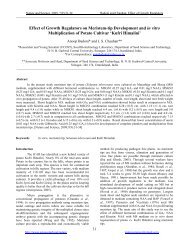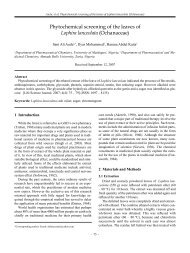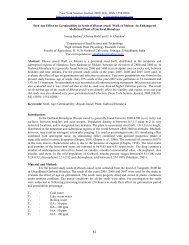Ecological, Social and Commercial Role of Lichens in India with ...
Ecological, Social and Commercial Role of Lichens in India with ...
Ecological, Social and Commercial Role of Lichens in India with ...
You also want an ePaper? Increase the reach of your titles
YUMPU automatically turns print PDFs into web optimized ePapers that Google loves.
[<br />
Acdemia Arena 2010, Supplement 0201<br />
http://www.sciencepub.net<br />
Chapter-10<br />
LICHEN RESOURCE USE PATTERN AND ITS SOCIO-<br />
ECONOMIC STATUS IN TEMPERATE REGION OF GARHWAL<br />
HIMALAYA, INDIA<br />
ABSTRACT: The resource use pattern <strong>of</strong> some macrolichens <strong>and</strong> their socioeconomic status <strong>in</strong><br />
temperate region <strong>of</strong> Garhwal Himalayas has been discussed. Out <strong>of</strong> five blocks, stakeholders <strong>of</strong><br />
Narayanbagar <strong>and</strong> Dewal block are found highly dependent on lichen (macrolichens) based activity<br />
to conduct their livelihood.<br />
Key Words- Macrolichen biomass, Quercus semecarpifolia, Garhwal Himalaya<br />
INTRODUCTION<br />
Accord<strong>in</strong>g to the concept <strong>of</strong> Upreti et al (2005) the lichens have been household items <strong>of</strong><br />
<strong>India</strong>ns s<strong>in</strong>ce ancient times. In <strong>India</strong>, lichens collected from the temperate regions <strong>of</strong> the Himalayas<br />
are used <strong>in</strong>digenously <strong>and</strong> are explored. The Uttarakh<strong>and</strong> hills <strong>and</strong> Himanchal Pradesh are the ma<strong>in</strong><br />
areas <strong>of</strong> the lichen collection <strong>in</strong> <strong>India</strong>. The lichens are very slow grow<strong>in</strong>g plants. Because <strong>of</strong> their<br />
unique thallus composition, which is made <strong>of</strong> fungus <strong>and</strong> alga, they can not be cultivated <strong>in</strong> large<br />
scale like other plants. Thus, lichens grow<strong>in</strong>g <strong>in</strong> nature provide a basic raw material required for<br />
various uses <strong>of</strong> lichens. The lichens weigh very little when dry, thus a vast bulk <strong>of</strong> these plants is<br />
required.<br />
Mounta<strong>in</strong> <strong>and</strong> hillside areas hold a rich variety <strong>of</strong> ecological systems. Because <strong>of</strong> their vertical<br />
dimension, mounta<strong>in</strong> creates gradient <strong>of</strong> temperature, precipitation, <strong>and</strong> <strong>in</strong>sulation. In Uttarakh<strong>and</strong><br />
n<strong>in</strong>e <strong>of</strong> the thirteen districts comprise the expansion <strong>of</strong> lesser Himalaya. But <strong>with</strong> the pace <strong>of</strong> rapid<br />
modernization <strong>and</strong> <strong>in</strong>creas<strong>in</strong>g anthropogenic pressure on vegetation <strong>in</strong> general <strong>and</strong> on forest <strong>in</strong><br />
particular coupled <strong>with</strong> natural disasters, the Himalayan vegetation is rapidly deteriorat<strong>in</strong>g <strong>in</strong> its<br />
richness as well as diversity. However, <strong>in</strong> recent past there has been a deep concern <strong>and</strong> realization<br />
for the conservation <strong>of</strong> the fragile Himalayan ecosystem.<br />
96






